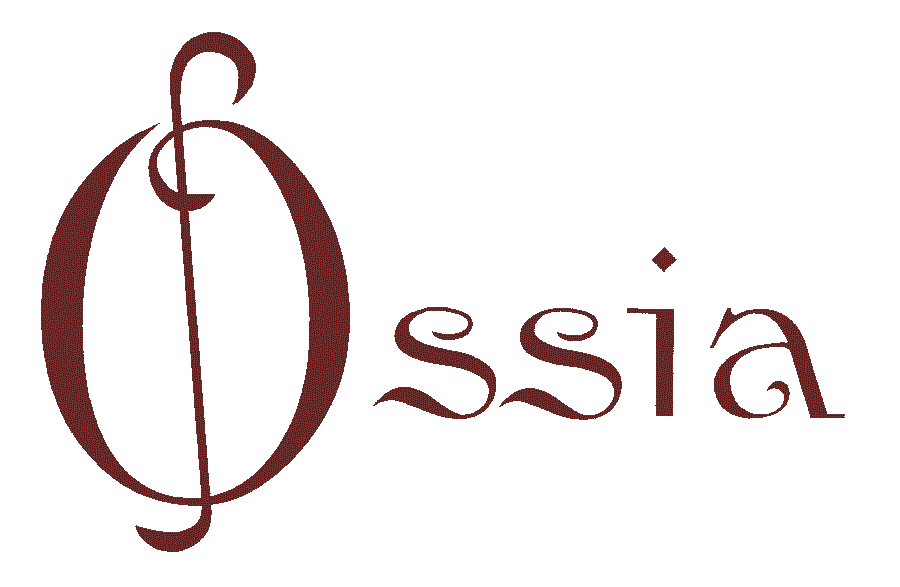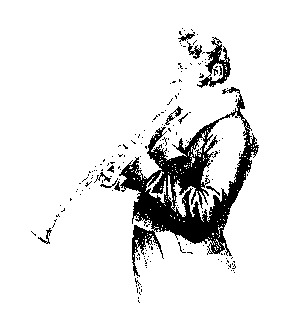

 |
 |
|
Maureen
Forrester Recital Hall
Part of the Music at Noon concert series Information: tel (519) 884-0710 ext. 3554
Stephen Fox, clarinets
Trio in Bb Op. 11
Ludwig van Beethoven
Trio in a Op. 114
Johannes Brahms
This concert presents the two best-known trios for clarinet, cello and piano, on instruments of the types that would have been heard by the composers and listeners when they were first performed. ~~ In 1798, the 28 (he would have claimed 26) year old Ludwig van Beethoven (1770-1827) was well established in the musical life of Vienna, having moved there from his native Bonn five years earlier, as a virtuoso pianist (renowned in particular for his improvising exhibitions and duels, a popular spectator sport of the time) and a composer with a growing reputation. Of the music written in this period he later claimed “At that time I had no idea how to compose.” He may not yet have found his mature voice (he was modest enough to continue lessons in composition with Antonio Salieri until 1802, for example), but most listeners would recognise in Beethoven’s early music the same genius as in his later works, albeit in a lighter form. His writing for wind instruments in particular is dominated more by a buoyant and genial spirit than by angst, by melody rather than by motivic development. The Trio Op. 11 was written and first performed early in 1798. It was dedicated to one of Beethoven’s most ardent admirers, Countess Thun (the mother of Prince Lichnowsky, a patron of Beethoven's and his first landlord in Vienna), and apparently was composed partly at the instigation of the clarinettist Josef Bähr, one of Beethoven’s favourite collaborators at this time. (Bähr is usually, but erroneously, confused with the much better-known Joseph Beer, who by a remarkable coincidence also worked briefly in Vienna in the 1790s. Of Bähr a commentator wrote: “…this artist possesses, in addition to extraordinary facility and assurance, an extremely charming and agreeable tone, and he is able, especially in piano passages, to make it so melting, tender and touchingly delicate that there will surely be few comparable masters of his instrument”. A more succinct testimonial from a musical colleague was that "Bähr blows like a god.") The first movement displays the quirkiness and instant about-faces that led to Beethoven’s music being labelled “unnatural” (one reviewer in 1799 wrote “It is undeniable that Herr Beethoven goes his own way; but what a bizarre and painful way it is!”); two centuries later it doesn’t seem so odd. The third movement is a set of variations on a popular tune of the time, the aria Pria ch’io l’impegno from the then-smash hit opera L’amor marinaro by the now largely forgotten Joseph Weigl; the same theme was used as a basis for improvised variations by numerous pianists, and by Paganini in a showpiece for violin and orchestra. Beethoven reportedly regretted following vulgar fashion in this way, and planned - but apparently never found the time - to replace this movement with something more original. ~~ In 1891, at the age of 58, the still-vigorous Johannes Brahms (1833-1897) had grown weary of the pressure to produce new music and had announced his intention to retire. It is an oft-told story that meeting and hearing a performance by Richard Mühlfeld (1856-1907), principal clarinettist with the orchestra of the Duke of Meiningen, inspired Brahms to a new burst of creative activity, leading to the Trio Op. 114, the Quintet Op. 115 and the later (in 1894) the Sonatas Op. 120, his penultimate compositions. While his retirement would undoubtedly not have lasted in any case, it is nonetheless quite certain that without this stimulus, even if Brahms had composed such significant chamber music at that point in his career, he would never have considered using the clarinet as the central instrument. Except possibly for Joseph Joachim, no instrumentalist had as great an impact on Brahms as Mühlfeld, to whom he gave such nicknames as "meine Primadonna", "fräulein Klarinette" and "the nightingale of the orchestra". It has been said that "Perhaps the clarinet pieces are the only true love songs to an instrument Brahms ever wrote" (Jan Swafford). The Trio in A minor Op. 114 displays a variety of moods and emotions that could hardly be wider (more so than, for example, its cousin the Clarinet Quintet). The first movement (whose opening theme is said to have been chosen by Brahms for his unwritten Fifth Symphony) sobs with bleak melancholy; the adagio second movement glows with loving warmth; the third, a surpassingly graceful Viennese waltz with a yodeling Ländler middle section, brings to mind Brahms’ close friend and summertime neighbour Johann Strauss Jr.; and the finale, alternating between fiery passion and sardonic wit, exemplifies Brahms’ fondness for “Gypsy” and quasi-Hungarian musical style. ~~ The description “Never more beautiful tones” was actually applied to Heinrich Baermann, Weber’s clarinettist, but we feel justified in using it to headline this concert, because of the reputations of the original performers of the Beethoven and the Brahms Trios, and of course because of the music itself. (Hmm... Bähr, Beer, Baermann, also Friedrich Beer alias Frédéric Berr... was there some connection between bears and clarinet playing in Germany around 1800?!)
Beethoven’s career witnessed the evolution of the piano from the Classical fortepiano to instruments recognisably on the path towards modern pianos. The fortepiano of Mozart’s time, as exemplified by makers such as Johann Andreas Stein of Augsburg and Anton Walter of Vienna, had a small range of five octaves (FF to f’’’), and knee levers instead of pedals to raise the dampers and to apply muting. A lightweight wooden frame with consequent low string tension, leather covered hammers, and light, simple, direct action combined to produce an incisive, percussive sound with little volume or sustaining power, and a touch that encouraged subtle articulation. This is the instrument on which Beethoven’s earliest works would have been performed, and here for the Trio Op. 11 we use a modern reproduction by Thomas McCobb of a fortepiano on the pattern of Anton Walter. Paralleling the development of the piano was a fundamental change in the way it was played, with the earlier, mostly separated, harpsichord-influenced approach being replaced by a dominantly legato style around 1800 (in a conversation with his pupil Czerny, Beethoven asserted that Mozart “used a technique entirely unsuited to the piano”). The piano used in the Brahms Trio is by the Viennese maker Johann Baptist Streicher (1796-1871), built circa 1848 and virtually identical to the one Brahms owned and used in his apartment in Vienna until the end of his life. Roughly intermediate in both sound and construction between a Classical fortepiano and a modern piano, it has a wooden, not iron, frame (there are, however, two small iron inserts and a stabilizing rod), with consequently lower string tension and hence less power than a modern piano. With a range of seven octaves and a length of 2.3 metres, it approaches a modern concert grand piano in size and compass. It has typical Viennese action (quite different from the mechanism of a present-day grand piano); it is parallel- rather than overstrung; and the hammers have deerhide covering over the felt. This last feature largely accounts for its distinctively incisive sound. By the 1890s a piano of this type was very old fashioned in international terms, following the adoption in most places of modern designs in the 1870s and '80s, though Vienna remained an outpost of conservative piano making until later than other centres. This particular example was latterly in the collection of Edwin Buenk in the Netherlands, who restored it and in whose ownership it was used for performances and recordings by several distinguished artists. It was purchased in 1997 by the Faculty of Music at Wilfred Laurier University. ~~ The clarinet of the Classical period was made of boxwood, with normally five (often six by 1800) simple brass keys with flat, square leather pads. The mouthpiece was also of wood, and it and the reed were considerably smaller than their modern counterparts. A much lighter, more subtle playing approach was employed compared with the present day, to provide the flexibility to deal with uneven response and some very difficult notes (notably C# and Eb in the low register, which were wisely avoided whenever possible by composers, and low B natural, which unfortunately was not). As with the piano and string instruments, playing style emphasised articulation rather than slurring. The clarinet employed here for the Beethoven is an original by G. Astor & Co. of London (marked in the name of the dealer Cramer), dating from ca. 1800-1820. Typically of English clarinets of the time, it has a side A-B trill key in addition to the basic five, and a long-tenon mouthpiece which is quite different in shape from Continental models. (For a general pictorial description of the Classical clarinet, click here.) The Baermann System clarinet is featured in the Brahms. Patented by the clarinettist and teacher Carl Baermann (1810-1885) and the Munich woodwind maker Georg Ottensteiner (1815-1879) in 1860, this design became the dominant clarinet in Germany until it was superseded by newer models developed from it around 1900 (Richard Mühlfeld, however, remained faithful to the Baermann clarinet until his death in 1907). It is midway between clarinets of the Classical period and those of the present day, combining the boxwood body, wooden mouthpiece and mostly cylindrical bore shape of the former, with rationally placed and sized tone holes, modern key mounting and complex, ergonomic keywork which is not far removed from that on current German clarinets (with a few significant fingering differences). Compared with the modern so-called Boehm System clarinet, the tone is sweeter, clearer and more compact, with less power but more subtlety. This particular example is a reproduction, built by the performer, of a clarinet in A by Wilhelm Hess Jr. (1841-1880) of Munich. (For more information on the Baermann System clarinet, click here for a scholarly article, or here for a pictorial description.) ~~ The fundamental design of the bodies
of stringed instruments had reached its current state by the late 17th
century; subsequent development took place in the areas of the neck and
fingerboard, the strings and the bow. The Classical period and the
early 19th century were a time of transition, during which instruments
were fitted with longer and more angled necks, longer and more tapered
fingerboards, more arched bridges, and heavier soundposts and bass bars.
At the same time, the short, highly arched Baroque bow gave way first to
a “transitional” bow and then to the modern style, Tourte pattern bow,
with its longer, stronger, concave stick and wider, tighter, more readily
adjusted bowhair. The holding position of the bow changed correspondingly.
All of this led to an evolution in the idioms of bowing, articulation and
musical expression, the emphasis switching from delicate articulation to
smooth legato, along with more power and projection. Strings until
into the 20th century remained a combination (with many regional differences)
of plain gut, twisted gut, and often for the larger strings gut core with
silver or copper winding. Two cellos are used in this performance:
for the Beethoven, a Baroque model with gut strings and a Classical bow
and with no endpin (which did not enter general use until the mid 19th
century); for the Brahms, one set up in the 19th-20th century style, with
silver-wound gut strings and a Tourte-model bow.
|
|